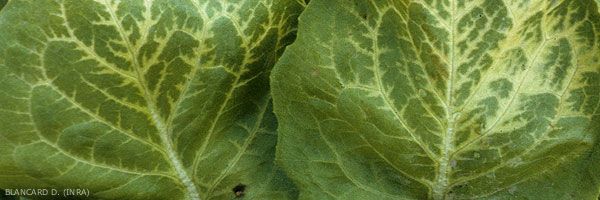
Various phytotoxicities
Among the pesticides used in agriculture, herbicides and, to a lesser extent, insecticides and fungicides , are likely to cause sometimes significant damage to lettuce.
We suggest that you consult a set of photographs which materialize the color anomalies, mainly yellowing , caused by certain herbicides on salad leaves. These yellows can have different intensity and distribution on the leaves:
- yellowing in spots, in more or less well defined areas, sometimes progressing to tissue necrosis (figure 1);
- yellowing of the veins and contiguous tissues (figures 2 to 4);
- yellowing of young leaves at the apex (figure 5);
- diffuse yellowing of the leaf blade between the veins, progressively intensifying (figures 6 to 8);
- diffuse yellowing of the entire blade;
- yellowing and dryness between the veins evolving rapidly;
- more or less homogeneous yellowing of the blade between the veins, sometimes progressing to bleaching;
- bleaching of the leaf blade ...
Using a herbicide on or near a crop is never a completely trivial matter. The risks of phytotoxicity are never completely ruled out.
We can also observe other symptoms as a result of phytotoxicity on salads and in particular:
- reduction in growth and leaf deformation ;
- more or less extensive necrotic leaf lesions ;
- leaf wilting and drying out ;
- root proliferation (figure 9) ...
Some characteristics of the main types of herbicides used in agriculture:
- Photosynthesis inhibitors (diquat, paraquat)
These foliar herbicides are in contact and migrate little.
The symptoms are characterized by wilting, drying out and leaf necrosis.
Main cellular alterations and disrupted functions
- alterations of cell membranes (plasma, tonoplasmic, etc.);
- stop the assimilation of CO 2 ;
- inactivation of the electron transfer system;
- increased membrane permeability;
- decrease in the content of chlorophyll and carotenoids ...
- Pigment synthesis inhibitors (carotenes) (aminotriazole, pyridazinones ...)
These foliar herbicides migrate into plants.
Symptoms
- slower growth;
- formation of light yellow to white stems and leaves (albino).
Main cellular alterations and disrupted functions
- selective action on the chloroplasts which are more or less deprived of their internal lamellar system;
- inhibition of the synthesis of carotenes;
- then disappearance of the chlorophyll which is no longer protected;
- reduction of nitrogen metabolism;
- decrease in the activity of certain enzymes (catalase, etc.).
- Cell division inhibitors (antimitotics) (Carbamates, pendimethalin, butralin, carbetamide, propyzamide ...)
These herbicides are incorporated into the soil and act by vapor. They are metabolic poisons reminiscent of colchicine.
Symptoms
- growth arrest and swelling of the meristems;
- club-shaped root ends;
- inhibition of the formation of lateral roots.
Main cellular alterations and disrupted functions
- inhibition of mitoses which remain blocked at the metaphase;
- absence de microtubules.
- Fatty acid inhibitors (Thiocarbamates, butam, difenamide, propyzamide ...)
These herbicides are incorporated into the soil and absorbed by the leaves and roots.
Symptoms
- inhibition of germination and emergence of plants;
- reduction in growth;
- leaf deformation and appearance of necrosis at the edge of the blade ...
Main cellular alterations and disrupted functions
- decrease in the amount of epicuticular waxes;
- inhibition of fatty acid synthesis;
- increased permeability of the cuticle;
- increased root water absorption;
- inhibition of the synthesis of gibberellic acid;
- inhibition of protein synthesis ...
- Auxinic (hormonal) herbicides ( pichloram, MCPA, 2,4-D, 2,4,5-T, dicamba ...)
These herbicides are taken up by the leaves and migrate through the phloem to the meristems. They are high concentration contact fungicides.
Symptoms
- slight wilting of the plants;
- numerous deformations and fasciation of the whole plant;
- leaf deformation and appearance of necrosis at the edge of the blade ...
Main cellular alterations and disrupted functions
- cessation of the activity of primary meristems and activation of secondary meristems;
- hypertrophy of vascular tissues ...;
- excretion of H + ion and entry of potassium (K) and water;
- activation of parietal hydrolases;
- increased synthesis of DNA and proteins (enzymes);
- increase in ethylene production.
- Amino acid synthesis inhibitors (glyphosate, Sulfonylureas-chlorsulfuron, Imidazolinones ...)
These foliar herbicides are typically symplastic. They are quickly degraded in the soil. Their mode of action is independent of photosynthesis.
Symptoms
- slower growth;
- chlorosis of the leaf blade and leaf deformations;
- appearance of leaf necrosis ...
Main cellular alterations and disrupted functions
- disorganization of the chloroplasts of the apical parts ...;
- decrease in the chlorophyll content;
- reduction in the auxin content of the treated tissues;
- disturbance of the absorption of potassium, calcium and magnesium;
- inhibition of the functioning of 5-enolpyruvylshikimate-3-phosphate synthetase and therefore of the formation of phenylalanine, tyrosine and tryptophan.





